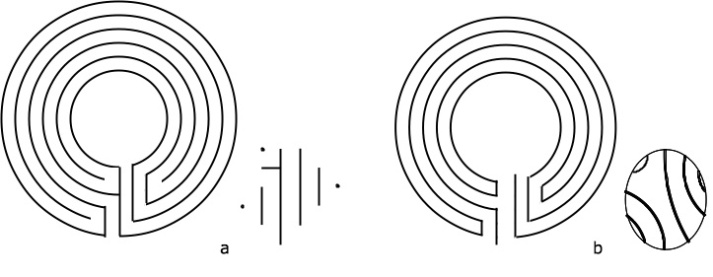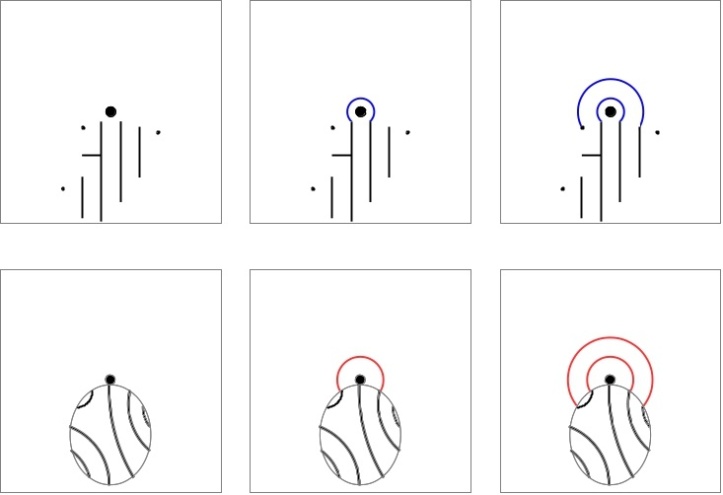In February 2011, Erwin had published a new graphical representation of the seed pattern for the Cretan-type labyrinth on this blog.
Several posts have been added in the meantime.
This graphical representation is unique in that it shows the seed pattern for the Ariadne’s Thread. This is different from previous publications, which always had shown the seed pattern for the walls of the labyrinth.
We can therefore state that the seed pattern exists in two forms of graphical representations: one for the walls and one for the Ariadne’s Thread. Ultimately, this is not surprising, as there also exist the same two graphical representations of the labyrinth itself. This can either be drawn with the walls shown and leaving a space between them for the path. Or it can be drawn with a line following the path of the labyrinth, i.e. with the Ariadne’s Thread. The Ariadne’s Thread is the simplest graphical representation of a labyrinth and in a unicursal labyrinth can always be drawn in one solid line.
The figure below shows the two graphical representations of both, the labyrinth and the seed pattern of the same one labyrinth. As usual I don’t use the Cretan-type but another simple one-arm labyrinth. I chose this because it is a small, simple, non self-dual core-labyrinth with no added detail.
a: the walls; b: the Ariadne’s Thread
This figure shows that the seed pattern for the walls may look quite different from the look we are used to by the seed pattern of the Cretan-type labyrinth (central cross, four angles and dots).
Also, even though a ellipse encloses the seed pattern for the Ariadne’s Thread, this is only an auxiliary line. Exclusively the seeds, i.e. the system of solid lines, determine the seed pattern for the Ariadne’s Thread. This is the same as with the seed pattern for the walls that has always been drawn without auxiliary lines.
The purpose of a seed pattern is that it quasi automatically completes to the whole labyrinth. The only information absolutely required for this is where the center of the labyrinth is localized on the seed pattern. In my illustrations I use a bullet to mark the center (and an arrow to mark the entrance). Once the center has been localized, the seed pattern can be completed straightforward to the labyrinth.
The next figure shows how the seed pattern is completed for both, the walls (upper row) and the Ariadne’s Thread (lower row).
In the seed pattern for the walls, the center always lies in a space between two ends / dots, whereas in the seed pattern for the Ariadne’s Thread it is connected with one of the seeds. In order to complete the seed pattern one has to connect the two ends next to the center with an arch around the center. In the seed pattern for the walls, this arch represents the innermost wall. In the seed pattern for the Ariadne’s Thread it represents the innermost circuit of the labyrinth. To this are then attached the neighbouring walls / circuits in consecutive order from the inside out. Finally there remains one empty space / end, where the entrance to the labyrinth is located. The figure shows the first two steps of the completion.
Click here for a step by step completion of the whole labyrinth.
The discovery of the seed pattern for the Ariadne’s Thread supplements the well-established seed pattern for the walls. It further invites and inspires to re-examine established knowledge and explore further thoughts. In further posts I will present some more thoughts about the following subjects:
- Drawing the seed patterns for both, the walls and the Ariadne’s Thread of known historical one-arm labyrinths shows the differences between these two forms of graphical representations and a great variety of different seed patterns.
- Shifting the localization of the centre in the seed pattern shows, that the same seed pattern can be used to create a variety of figures, all without crossroads or junctions. However not all of these figures are labyrinths in the strict sense. In addition to labyrinths, also composed figures with core-labyrinths and added circuits or figures with isolated sub-figures may result.
- The seed pattern can also be drawn for labyrinths with more than one arm.
- And, even though they are not the same, the seed pattern and the pattern are closely related to each other.



Pingback: Variants of the Cakra Vyuh Seed Pattern | blogmymaze
Pingback: From the Labyrith to the Pattern | blogmymaze
Pingback: The Seed Pattern in Labyrinths with Multiple Arms | blogmymaze
Pingback: How to Draw a Man-in-the-Maze Labyrinth | blogmymaze
Pingback: Variants of the Same Seed Pattern / 1 | blogmymaze
Pingback: The Cretan at the Crossing Point | blogmymaze
Pingback: What is Special about the Cretan Labyrinth | blogmymaze
Pingback: Seed Pattern – Shifting the Center / 2 « blogmymaze
Pingback: Seed Pattern – Shifting the Center « blogmymaze